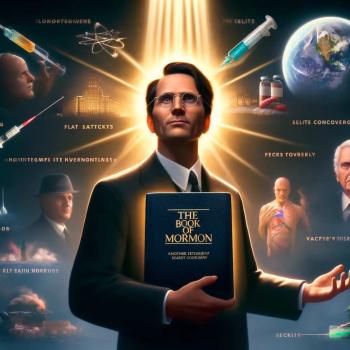A couple weeks ago, my wife received a group text message from someone in our ward inviting several couples to go together to watch the movie “The Oath”, which was self-labeled “the first Ancient American epic set in the pre-Columbian New World”.
I had casually followed the movie’s developments for more than eight years, after learning from Darin Southam (the movie’s producer, who for some reason is now calling himself Darin Scott) about his desire to finally tell the story of The Book of Mormon in a compelling way that would finally give legitimate theatrical attention to the ancient prophets and warriors who are heroes to my family and millions of other Mormons. In fact, I had participated in multiple discussions with Darin about how to use the internet and social media to build support for the worthy goal of introducing The Book of Mormon and its inspiring stories of spirituality, faith, war, and survival to the world in a way that brought honor and recognition to those whose efforts caused the book to exist in the first place.
It is with that background and hope for the movie’s success that my wife and I attended the 8:30pm showing on opening night of The Oath at the AMC movie theater in Murfreesboro, Tennessee. My wife and I debated whether to buy tickets prior to going to the theater, then finally reasoned that the show would likely not be sold out, since it was unlikely that many people in the Nashville area would even know about the movie’s release.
We were right.
When we walked into the theater with the two other Latter-day Saint couples we had come with, we were a bit surprised to find that we were the only six people in the theater. I thought there would be at least a smattering of an audience even this far away from any LDS communities, but it was just the six of us sitting through all of the previews waiting for the movie to start. After 15 minutes of previews, one other person wandered into the theater for a few minutes, then left.
As I sat through the first few minutes of the movie, I had hopes that we’d get to see a well-developed story depicting Captain Moroni as he led the fight for freedom among the Nephites. Maybe we would see the portrayal of some of the political happenings that led to the Nephite society deciding to choose judges to lead them instead of having a king, an inspired revolution of the way government was done among the society that preceded ours on the American continent. Surely we’d see some of the epic battles that were fought as the Lamanites repeatedly went on the offensive against the Nephites, attempting to take away their liberties and enslave them.
I was especially hopeful that the movie would include something about the prominent theme of secret combinations as they’re repeatedly warned about in The Book of Mormon. Modern society is badly in need of a reminder that conspiracies done by evil people can destroy entire civilizations.
But nope. None of that was in the movie. Instead, my wife and I found ourselves chuckling about how awkward the movie had become over its first half hour of content.
Rather than showing any of the things that the majority of ticket holders would have expected, The Oath became an awkward love story that felt like it landed somewhere between Braveheart and Napoleon Dynamite. Much of the time it was difficult to figure out where the plot was going, and many of the scenes didn’t seem to fit or provide context.
Here is a quick summary of how the movie unfolds. While Moroni is living in a cave after having witnessed his civilization destroyed in war, he happens upon a Lamanite woman named Bathsheba, a concubine of the Lamanite king. This woman had fled after being beaten by the king, and she ends up crossing paths with Moroni, who she warms up to as he cares for her. After trying to seduce Moroni, she ends up marrying him in a wedding ceremony that he officiates. Shortly after the wedding ceremony, she becomes pregnant with his child. Moroni later finds that she has been murdered by the Lamanites who had been tracking him throughout the movie. The movie then ends with Moroni burying the plates that he has been shown handling throughout the movie.
One very disappointing but not surprising element of the movie was that it was clearly a priority to demonstrate that Darin, who plays the character who you’re supposed to believe is the prophet Moroni, has been working out. Starting from the opening scene, which includes what looks like an ancient American workout session (complete with lat rows using rocks as weights) exaggerated effort is made to show his arms, chest, back, and legs from every angle possible. Darin flexing scenes are thrown in throughout the movie, often without much context as to why we need to be reminded again, “Hey, this guy has been hitting the weights!”
Instead of inspiring scenes about wars, spiritual and physical principles, and the battle between good and evil, the movie consists of mostly awkward scenes that aren’t very well put together. Here are a few examples.
Scaring a Bear From Their Cave
As Moroni and Bathsheba are returning to their cave on one occasion, they notice that a bear has decided to occupy the cave. Bathsheba repeatedly directs Moroni to kneel down, which he finally does without understanding why. She then climbs on his back and tells him to stand up, apparently making it appear as if they are a larger creature. When the bear eventually comes out of the cave, they scare him away. The only shot of the bear that is shown is a stock image of a small black bear running through a meadow. The scene is almost comical.
Shooting at Rolling Rocks
In an attempt to demonstrate that Bathsheba is a serious, skilled woman, several minutes are spent showing her shooting an arrow at a rock after it is rolled down a small hill. She hits the rock each time, then gives Moroni the chance to try. He misses the rock over and over, until she tells him to shoot at it as if it’s a rabbit, and he is starving. Upon receiving that direction, Moroni shoots the arrow and hits the rock.
Moroni Whispering While Lying in the Grass
The movie repeatedly uses flashbacks in an attempt to create a sense of nostalgia or poignancy. One of these scenes is Moroni lying in the grass contemplating life. The scene continues long enough to make it awkward the first time, let alone at other points in the movie. While lying on his back in the grass, Moroni is heard whispering things in his head. It feels like they are trying to fill time with something that comes across as being nostalgic, but that misses that target.
In order for this film to be shown in more theaters throughout the country and internationally, it would need to have a large show of support. Sadly, this film won’t have many people watching it besides those who have a vested interest and those who, like me, just didn’t realize how bad it was going to be.
I don’t recommend spending money on this movie, but if it ever shows up as an option on Living Scriptures, it might be worth spending some time on a Sunday afternoon watching it.













